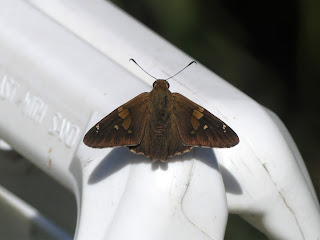Silver-spotted Skipper
Where's the silver spot [1] on this Silver-spotted Skipper? It's (almost certainly) there, but it's really only visible on the underside of the wing. Many times these butterflies rest with their wings held up, and their silver spot actually is a pretty prominent field mark. I don't know if this particular skipper was trying to maximize its exposure to sunlight, but it had the wings held down, and the silver spot isn't in evidence. If you only see this angle, it can make identifying this butterfly trickier. Despite this view, the silver spot gives this butterfly a reputation as the country's most recognizable skipper. [2]
Most of the skippers I meet are grass skippers, where the caterpillars feed on some sort of grass. Silver-spotted Skippers are definitely not in this group; their caterpillars eat plants in the legume family like Black Locust, Honey Locust, and wisterias. (Like good children, their caterpillars eat their vegetables.)
The Silver-spotted Skipper used to be placed in with the spread-wing skippers, but are currently (perhaps tentatively) in another subfamily these days. [3]
 |
| July 31, 2021 at Duke Farms Photo 149014497, (c) jpviolette, some rights reserved (CC BY-NC) |
For a view of that silver spot, you can check out this post.
[1] I'd personally consider it to be a white spot. A lot of times the names of plants/animals with colors in their names may not exhibit exactly that color in their appearance.
[2] This isn't saying much. The grass skippers tend to be small with somewhat similar yellow/tan/brown markings, while cloudywings and duskywings tend to be dark with small distinguishing marks.
[3] It might surprise you how much churn goes on in taxonomy, with species, genera, tribes, subfamilies, and families merging and splitting with regularity. Many times my field guides, while still being useful for identifying a plant/animal, place said plant/animal in an obsolete taxonomic niche.



Comments
Post a Comment